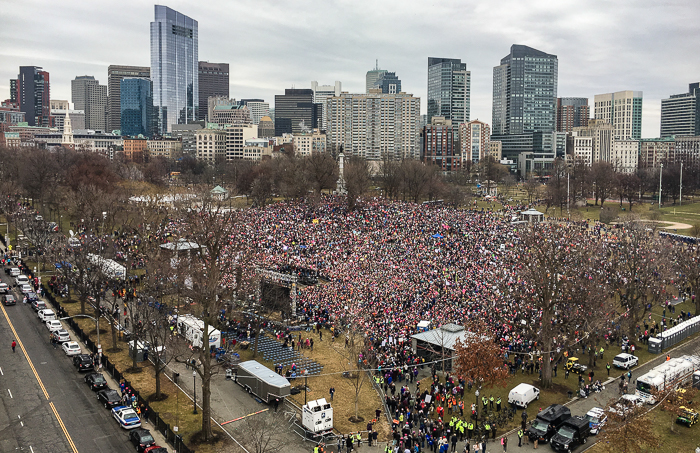A history of demonstration in American’s first park
The Women’s March on January 21 on Boston Common was just the latest in a long history of peaceful demonstrations on the Common.

photo credit: Greg Cook
“The Common has been at the center of Boston’s civic life since its establishment in 1634. Despite physical changes, the Common has remained a focal point for the community – from grazing cows and military activities to celebration, punishments, protests and recreation. Physically, as well, it has remained fairly consistent in size and character, a green respite in the midst of the city.” — Boston Common Cultural Landscape Report, prepared by Landscape Historian Shary Berg for Friends of the Public Garden
After rowdy demonstrations against the English Stamp Act and the tax on tea, the repeal of the Stamp Act in 1766 was cause for a huge celebration on the Common. Following the Revolutionary War, the Common was host to protesters of every stripe, and Presidents from Washington to Jackson visited along with other notables.When the Marquis de Lafayette visited in 1824, there were reportedly 70,000 spectators. Abolitionist and powerful orator Senator Charles Sumner gave speeches to sizeable crowds, and Massachusetts regiments were dispatched and mustered to fight in the Civil War. In 1893, Julia Ward Howe, of Battle Hymn of the Republic fame, demonstrated with 1,500 women against the laying of trolley tracks across the Common eventually resulting in the nation’s first subway. About 80% of the Boston police force went on strike in 1919 protesting against low wages ending with a showdown against federal troops at Brewer Plaza. When the governor of Massachusetts denied Sacco and Vanzetti a new trial in 1921, public outcry was exhibited by a large crowd including many police officers marching around Boston Common. As the depression deepened in 1932, Hunger Marches became common in cities across the country including Boston. War bond rallies and victory parades were center stage on the Common during World War II. Before the advent of TV, presidential candidates such as Dwight D. Eisenhower made campaign speeches to enormous crowds on the Common.
On April 23, 1965, Martin Luther King led a mile-long freedom march through Boston and onto the Common where he spoke from Parkman Bandstand. George McGovern spoke to some 100,000 at the Boston Common Vietnam Moratorium Rally in October 1969. The “Spring Offensive” brought over 25,000 young protesters to an anti-war demonstration in May 1971.
The largest single event on Boston Common to date is the visit from Pope John Paul II when he conducted the first papal Mass in North America for 400,000 people from a special podium on the Common. The latest demonstration of 175,000 people for the Women’s March illustrates the importance of the Common as an irreplaceable center of political and civic life in the City of Boston.

